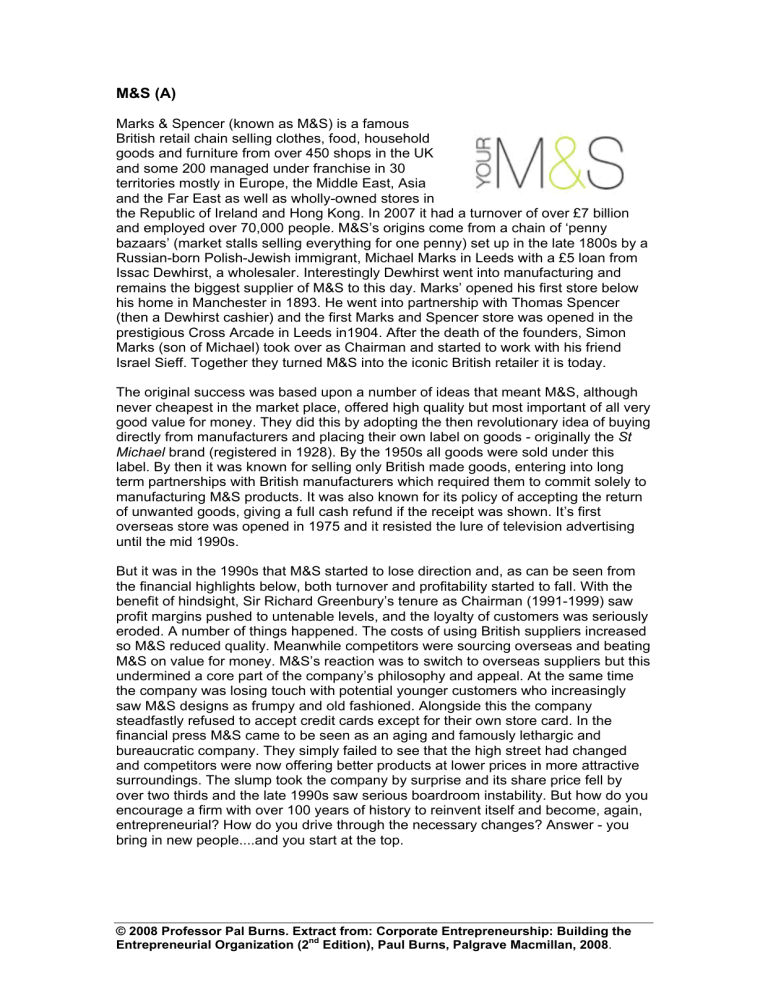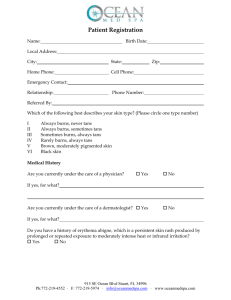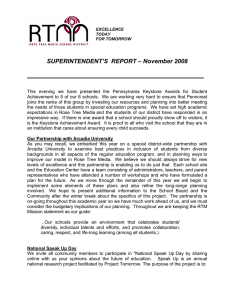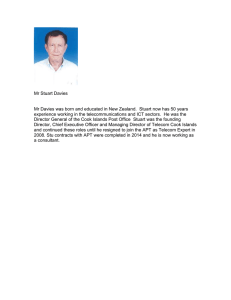
M&S (A) Marks & Spencer (known as M&S) is a famous British retail chain selling clothes, food, household goods and furniture from over 450 shops in the UK and some 200 managed under franchise in 30 territories mostly in Europe, the Middle East, Asia and the Far East as well as wholly-owned stores in the Republic of Ireland and Hong Kong. In 2007 it had a turnover of over £7 billion and employed over 70,000 people. M&S’s origins come from a chain of ‘penny bazaars’ (market stalls selling everything for one penny) set up in the late 1800s by a Russian-born Polish-Jewish immigrant, Michael Marks in Leeds with a £5 loan from Issac Dewhirst, a wholesaler. Interestingly Dewhirst went into manufacturing and remains the biggest supplier of M&S to this day. Marks’ opened his first store below his home in Manchester in 1893. He went into partnership with Thomas Spencer (then a Dewhirst cashier) and the first Marks and Spencer store was opened in the prestigious Cross Arcade in Leeds in1904. After the death of the founders, Simon Marks (son of Michael) took over as Chairman and started to work with his friend Israel Sieff. Together they turned M&S into the iconic British retailer it is today. The original success was based upon a number of ideas that meant M&S, although never cheapest in the market place, offered high quality but most important of all very good value for money. They did this by adopting the then revolutionary idea of buying directly from manufacturers and placing their own label on goods - originally the St Michael brand (registered in 1928). By the 1950s all goods were sold under this label. By then it was known for selling only British made goods, entering into long term partnerships with British manufacturers which required them to commit solely to manufacturing M&S products. It was also known for its policy of accepting the return of unwanted goods, giving a full cash refund if the receipt was shown. It’s first overseas store was opened in 1975 and it resisted the lure of television advertising until the mid 1990s. But it was in the 1990s that M&S started to lose direction and, as can be seen from the financial highlights below, both turnover and profitability started to fall. With the benefit of hindsight, Sir Richard Greenbury’s tenure as Chairman (1991-1999) saw profit margins pushed to untenable levels, and the loyalty of customers was seriously eroded. A number of things happened. The costs of using British suppliers increased so M&S reduced quality. Meanwhile competitors were sourcing overseas and beating M&S on value for money. M&S’s reaction was to switch to overseas suppliers but this undermined a core part of the company’s philosophy and appeal. At the same time the company was losing touch with potential younger customers who increasingly saw M&S designs as frumpy and old fashioned. Alongside this the company steadfastly refused to accept credit cards except for their own store card. In the financial press M&S came to be seen as an aging and famously lethargic and bureaucratic company. They simply failed to see that the high street had changed and competitors were now offering better products at lower prices in more attractive surroundings. The slump took the company by surprise and its share price fell by over two thirds and the late 1990s saw serious boardroom instability. But how do you encourage a firm with over 100 years of history to reinvent itself and become, again, entrepreneurial? How do you drive through the necessary changes? Answer - you bring in new people....and you start at the top. © 2008 Professor Pal Burns. Extract from: Corporate Entrepreneurship: Building the Entrepreneurial Organization (2nd Edition), Paul Burns, Palgrave Macmillan, 2008. Year ending March/April Turnover (£bn) Profit before tax (£m) 2007 2006 2005 2004 2003 2002 2001 2000 1999 1998 1997 1996 8.6 7.8 7.5 8.3 8.0 8.1 8.1 8.2 8.2 8.2 7.8 7.2 965 746 505 782 678 336 146 418 546 1,155 1,102 966 Basic earnings per share (p) 40.4 31.4 29.1 24.1 20.7 5.4 0 9.0 13.0 28.6 26.7 23.3 Sir Richard Greenbury retired in 1999 and Luc Vandevelde, a Belgian, took over as both Chairman and Chief Executive. He had previously been Chairman and Chief Executive of Promodès, the French hypermarket chain, where he oversaw a merger with Carrefour, its rival. Roger Holmes was brought in at about the same time and he became Chief Executive later in the year. Drastic action was called for simply to survive. Stores were closed on the Continent and in the US and jobs were cut as the company also closed down its Direct catalogue so as to enable it to focus on its core UK retail business. Sourcing was moved overseas, cutting back on UK suppliers, in order to increase margins and make prices more competitive. At the same time the supply chain was modernised, allowing clothes to be brought to market more quickly, bureaucracy was reduced and new talent brought in to drive innovation. Shops opened on Sundays and accepted credit cards. Clothing fashions were improved by bringing in new people. George Davies, founder of Next, was brought in to produce a young, fashionable collection called Per Una. In the same year Yasmin Yusuf, the brains behind the Warehouse clothing chain was appointed creative director. The fashion strategy became one of targeted sub brands, such as the Limited Collection label, Blue Harbour men’s casual wear, the Perfect range of classic pieces and the more expensive Autograph label which has designers such as Betty Jackson, Sonja Nuttall and Anthony Symonds. Fashion sales started to increase. By 2002 the company was gaining market share in areas like lingerie and men’s casual wear. New ways of presenting clothes meant the average spend increased as shoppers were encouraged to buy entire outfits rather than just single products. M&S started innovating again with products ranging from seam-free underwear to ‘steam cuisine’ microwave meals. It opened new convenience food outlets called Simply Food, targeting new markets. Some, within railway stations and motorway service areas are run by Compass Group, the specialist catering company, under franchise. Vittorio Radice, the brains behind the regeneration of Selfridges, the department store was brought in to experiment with stand-alone home ware stores the first of which was opened in Gateshead in 2004 © 2008 Professor Pal Burns. Extract from: Corporate Entrepreneurship: Building the Entrepreneurial Organization (2nd Edition), Paul Burns, Palgrave Macmillan, 2008. with the name Lifestore. But not all the initiatives worked and many of the underlying management problems remained. In 2004, amid rumours of a possible take-over bid, M&S announced that Chairman Luc Vandevelde would be leaving with immediate effect and that the Chief Executive, Roger Holmes would be replaced by Stuart Rose. At the same time Paul Myers, chairman of Guardian Media Group, took over as Chairman. Timing is crucial in business because shortly after this Philip Green, boss of the fashion retailers Arcadia Group, which includes Bhs stores, announced a take-over bid for M&S. Stuart Ross came to M&S with a track record of turning around struggling retailers. Indeed he is credited with turning around Arcadia Group, which is quite a coincidence. He was also a friend of Philip Green. Stuart quickly put together a recovery plan which included selling off the financial services business to HSBC Bank, buying control of the Per Una range, closing the Gateshead Lifestore (Vittorio Radice along with many senior managers subsequently left M&S) and stopping the expansion of the Simply Food outlets (there were about 20 at the time). Philip Green later withdrew his bid after failing to get sufficient backing from shareholders. Son of a civil servant, Stuart Rose was educated at a Quaker boarding school and started his career in retailing in 1972 after joining M&S as a management trainee. He remained with the company for 17 years, holding a variety of jobs in the textiles and food divisions before being appointed commercial director leading M&S’s European operation in Paris. In 1989 he joined Burton Group, which included Debenhams, Top Shop and Dorothy Perkins stores. The group later demerged into Arcadia and Debenhams. In 1998 he was appointed chief executive of the Argos catalogue/shop chain. Later as boss of Booker, the cash-and-carry business, he arranged a merger with the frozen food retailer Iceland and became the new group’s chief executive. He joined Arcadia in 2000, a company with £250 million of debt, which he turned around and then sold two years later to Philip Green for £855 million – making £25 million for himself. He took over as Chief Executive of M&S in 2004 at the age of 55. Although always smartly dressed, Stuart Rose is known for his informal management style that circumvents formal structures. If he wants to know something he is quite likely to go directly to the person who should have the answer rather than ask for a management report. He is seen as ‘very good at motivating people and giving them clear instructions. He brings the best out in people….a dedicated networker, always lunching someone from the City or the media….He maintains a helicopter position….(but nevertheless)….sits in on merchandising reviews, knows how many of which style is sold where, and can reel off financial data about each of his many retail chains at will’ (Times Online 25 January, 2007). He is also known for bringing in his own trusted managers to focus on the minutiae – which is precisely what he did, reshuffling and firing many of M&S’s top managers. For example, Steve Sharp was brought in as new Marketing Director. He met Stuart Rose at Debenhams where he was Marketing Director. At M&S he introduced the new Your M&S brand, together with the new clothing advertising campaign featuring the celebrated model Twiggy and younger models associated with the bohemian styles of 2005-6. He was also responsible for the TV advertising campaign for their food range featuring Derla Kirwan with the tag line ‘This is not just food, this is M&S food’. Managerial and directorial changes followed including the appointment in 2007 of Martha Lane Fox, co-founder of Lastminute.com, as non-executive director to advise on the company’s Direct business. Stuart Rose focused on three things; product, environment and service. Getting the product right was also top of the agenda. Many slow moving, expensive suppliers were replaced by quick-turnaround specialists, often overseas. Prices were often cut © 2008 Professor Pal Burns. Extract from: Corporate Entrepreneurship: Building the Entrepreneurial Organization (2nd Edition), Paul Burns, Palgrave Macmillan, 2008. whilst quality was maintained. Improving value, style and the amount of new product was important. In clothing the company initially focused on the classic designs it had historically always excelled at – the Classic Collection – but other lines have been expanded, particularly the Per Una range. It rationalised its menswear. For both menswear and womenswear it introduced innovative products such as machine washable suits and seam free underwear. In food M&S focused on offering high quality, innovative products such as the additive free ‘Marks and Spencer Cook!’ range. After a pause the Simply Food stores started to expand once more so that by 2007 there were about 200. Getting the environment right meant stores were completely redesigned with white tiles (black in Foods) replacing carpets and laminate flooring, brighter lighting, new product stands, display styles, mannequins, till points and staff uniforms. By 2007 some 35% of stores had been completely refurbished in this way and many others temporarily updated as part of a massive investment programme costing over £520 million. M&S also moved to improve its service levels by investing in its biggest ever customer service training programme based around the Mary Gober Method™ - called ‘Your M&S – Our Service Style’. Our Service Style is defined as ‘We are friendly, helpful, courteous people, who are knowledgeable and enthusiastic about taking care of our customers’. The company also overhauled its pay rates and improved career planning for its ‘customer assistants’, reducing grades to just four with clear progression. As well as attractive salaries staffs are paid a performance bonus, which in 2006 totalled £70 million or an average of £500 per employee. The company also has a saving scheme that allows staff to buy M&S shares at a 20% discount. As the turnaround gathered pace in January 2007 sizable bonuses were triggered – a total of £56 million or an average of £4,700 per member – based upon a share price that had tripled in less than three years. What Stuart Rose did in focusing on product, environment and service was to return to the core M&S value(s) propositions: • The M&S’s vision is ‘to be the standard against which all others are measured’. • The M&S’s mission is ‘to make aspirational quality accessible to all’. • M&S’s Values are ‘quality, value, service, innovation and trust’. ‘Our plan remains the same – to drive further growth from our core business through the delivery of better products, service and environment. We are also starting to broaden the business, by stretching the brand into new product areas, expanding space, driving our Direct business and growing our brand internationally.’ Up-to-date information on M&S can be found on their web site: www.marksandspencer.com. Questions 1. What are the lessons you learn from M&S about how to turn around an ailing, bureaucratic firm? 2. What lessons do you learn from Stuart Rose about the role of leader in this situation?’ 3. How important was it to change senior management at M&S? © 2008 Professor Pal Burns. Extract from: Corporate Entrepreneurship: Building the Entrepreneurial Organization (2nd Edition), Paul Burns, Palgrave Macmillan, 2008.


